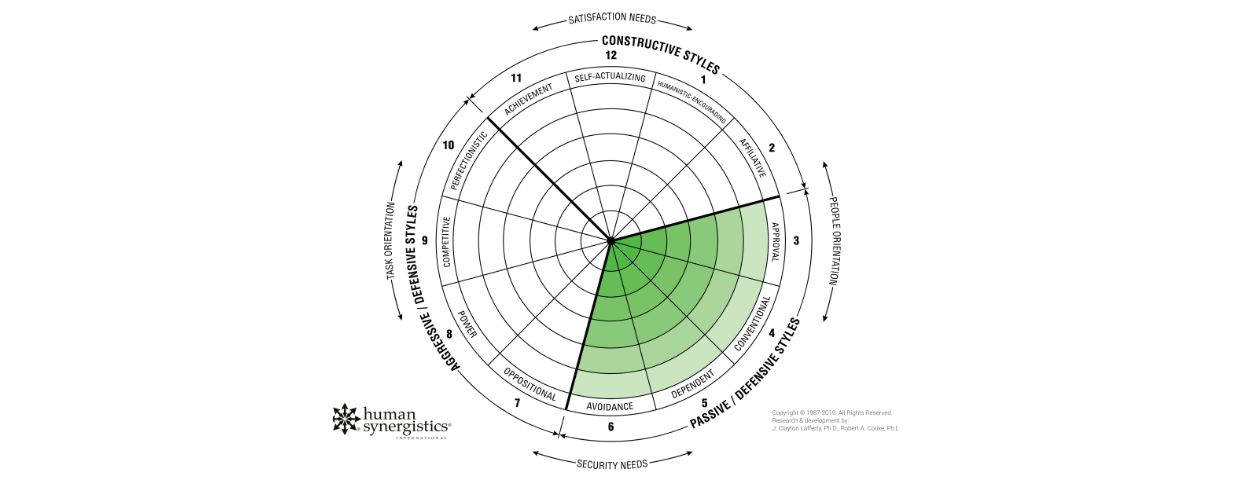Understanding the Passive/Defensive Cluster in the Group Styles Inventory (GSI)
When it comes to team performance, the way members think, interact, and solve problems together can make or break results. The Group Styles Inventory (GSI) by Human Synergistics is a powerful diagnostic that helps teams see how their collective thinking styles are influencing their effectiveness – and where they can improve.
In this article, we’ll explore what the GSI measures, what the Passive/Defensive cluster is, the styles it includes, and practical ways to shift a team towards Constructive styles that deliver stronger outcomes.
What is the Group Styles Inventory (GSI)?
The Group Styles Inventory is a research-based team assessment tool that measures how members approach problem-solving, decision-making, and working together.
Rather than focusing on individual personalities, the GSI looks at group thinking patterns – the shared beliefs and behaviours that shape how a team operates in the moment.
It maps these patterns against twelve thinking styles, organised into three clusters:
-
Constructive – styles that promote collaboration, creativity, and high performance.
-
Passive/Defensive – styles that limit open communication and proactive problem-solving.
-
Aggressive/Defensive – styles that create tension, competition, and control-focused behaviours.
By understanding where a team’s current thinking sits, leaders can make targeted changes to improve team culture and performance.
What is the Passive/Defensive Cluster?
The Passive/Defensive cluster in the GSI represents thinking styles where team members tend to hold back, avoid risk, and prioritise self-protection over open contribution.
These styles can result in missed opportunities, slower decision-making, and limited innovation – often because members are more focused on maintaining security and approval than challenging ideas or driving outcomes.
The Passive/Defensive cluster includes four specific styles:
-
Approval – Going along with the majority to gain acceptance, even if it means withholding concerns or alternative ideas.
-
Example: In a meeting, a team member disagrees with a proposal but stays silent to avoid being seen as negative.
-
-
Conventional – Sticking to tried-and-true methods and avoiding new approaches to reduce risk.
-
Example: A project group rejects an innovative idea because “we’ve never done it that way before.”
-
-
Dependent – Deferring to authority or dominant personalities instead of taking initiative.
-
Example: Team members wait for the leader to make every decision, even for routine matters.
-
-
Avoidance – Steering clear of conflict, responsibility, or potentially uncomfortable discussions.
-
Example: A group continually postpones a decision because no one wants to deal with potential pushback.
-
While these styles may create a surface-level sense of harmony, they often slow progress and reduce the quality of solutions.
5 Ways to Shift a Team Towards Constructive Styles
If your team shows strong Passive/Defensive patterns, it’s possible to reframe group dynamics and move towards the Constructive cluster, where thinking styles support problem-solving, trust, and accountability.
Here are five proven strategies:
-
Create Psychological Safety
-
Encourage open dialogue where all perspectives are welcome without fear of judgment.
-
Use round-robin discussion or smaller breakout groups to ensure every voice is heard.
-
-
Set Clear Shared Goals
-
Anchor team discussions to a common purpose and measurable outcomes.
-
This helps shift focus from self-protection to collective achievement.
-
-
Model Constructive Leadership
-
Leaders can set the tone by inviting feedback, asking open-ended questions, and acknowledging contributions – even when ideas are challenged.
-
-
Recognise and Reward Constructive Behaviours
-
Publicly highlight when team members take initiative, challenge respectfully, or propose innovative solutions.
-
Positive reinforcement helps make these behaviours the norm.
-
-
Build Decision-Making Skills
-
Train the team in collaborative problem-solving techniques such as consensus building, nominal group technique, or structured brainstorming.
-
This reduces dependency on authority figures and builds shared ownership of decisions.
-
Conclusion: From Playing it Safe to Performing
The Passive/Defensive cluster in the Group Styles Inventory reveals where teams might be playing it safe – sometimes to the detriment of creativity, speed, and results.
By recognising these patterns and intentionally shifting towards Constructive thinking styles, teams can unlock greater collaboration, innovation, and performance.
If you want to explore your team’s thinking styles and learn how to move from Passive/Defensive to Constructive, Human Synergistics’ Group Styles Inventory provides the insights and tools to make it happen.
